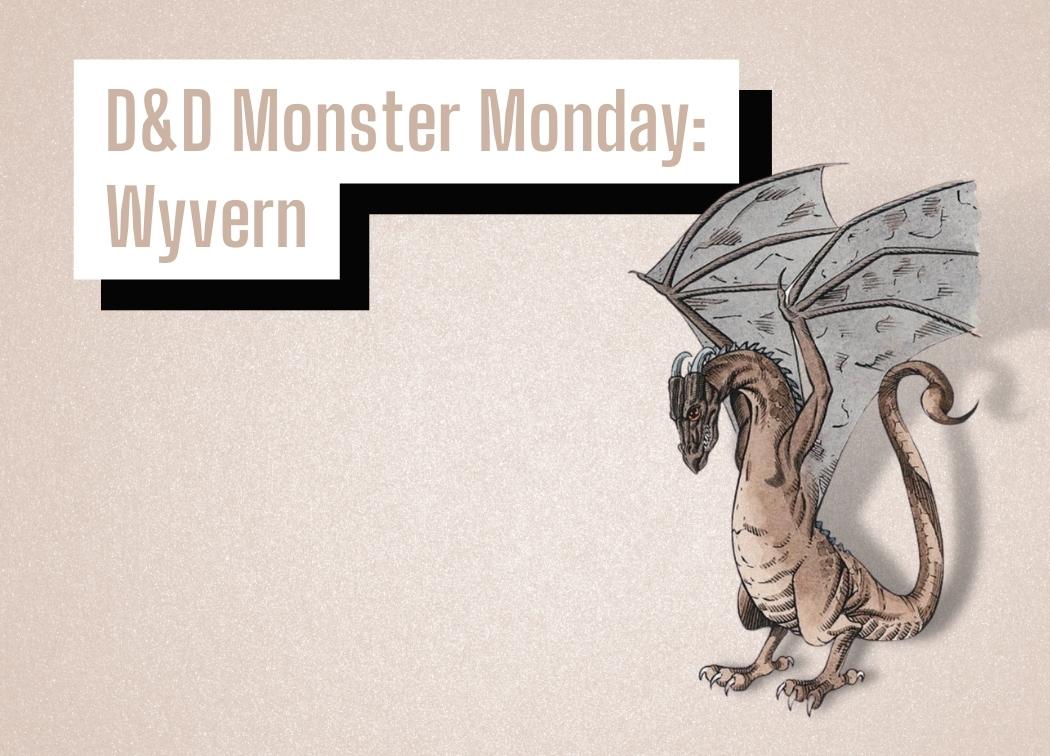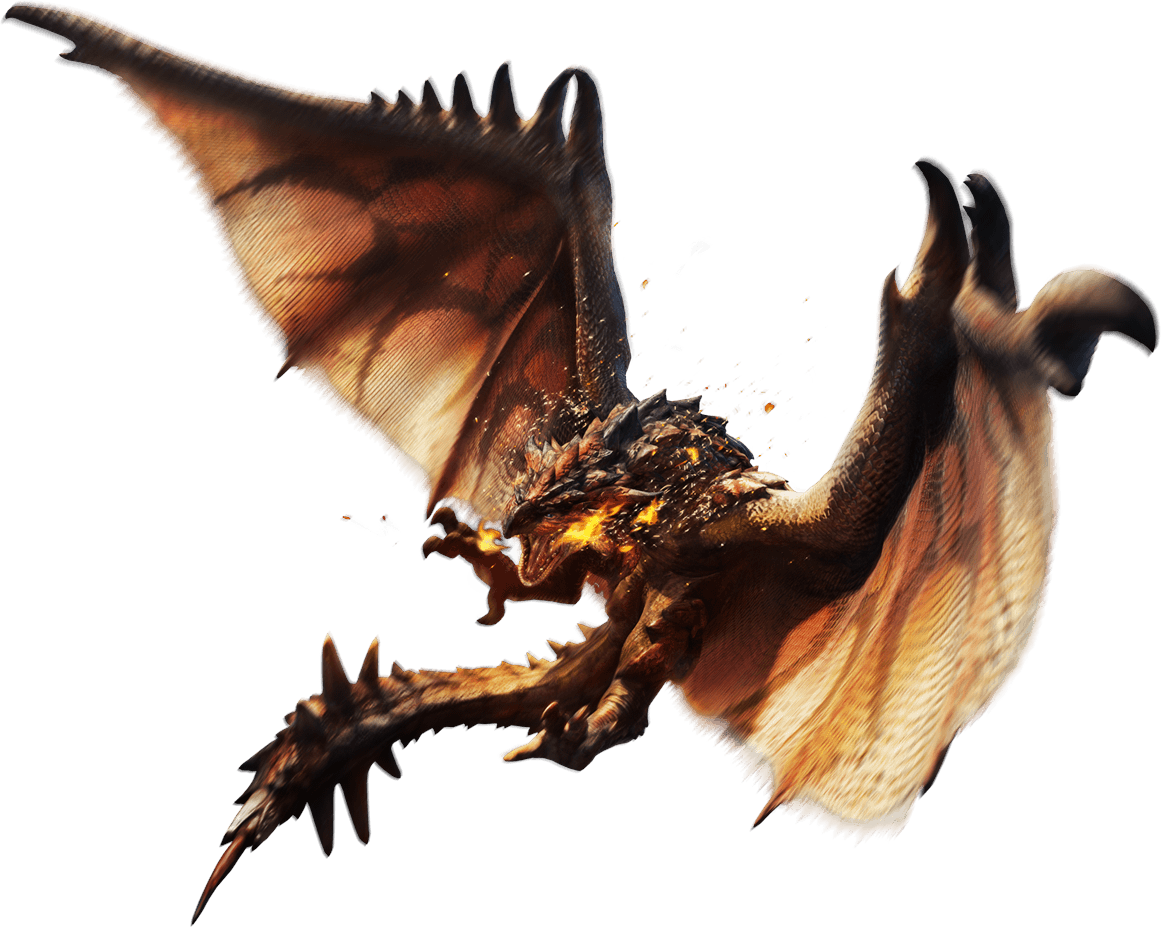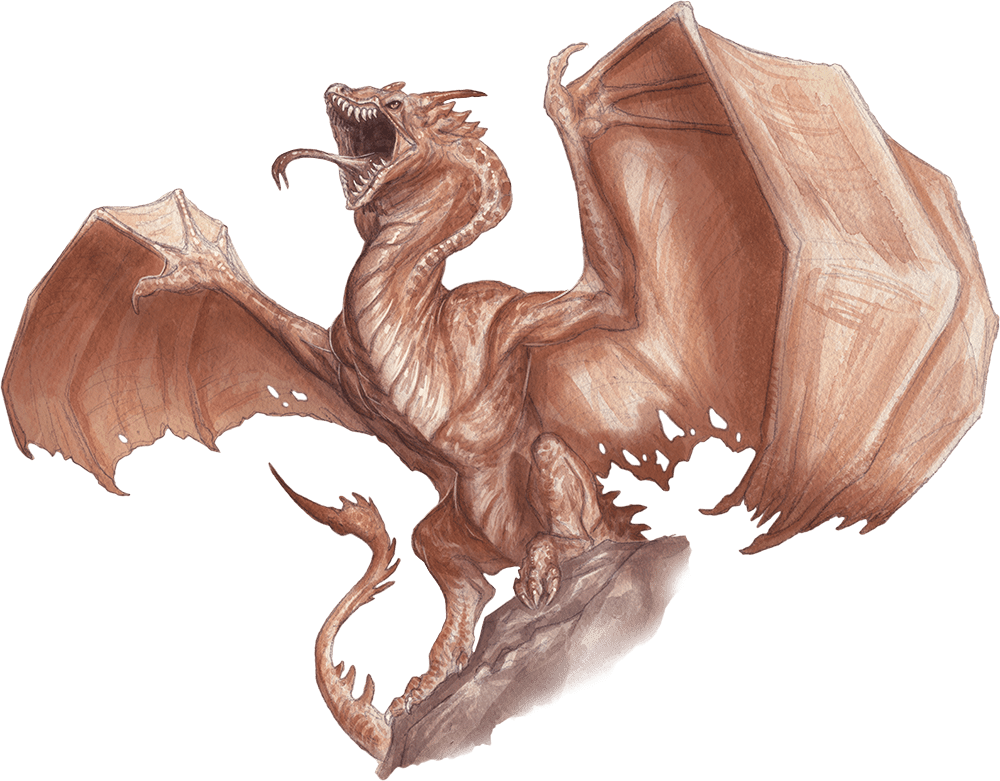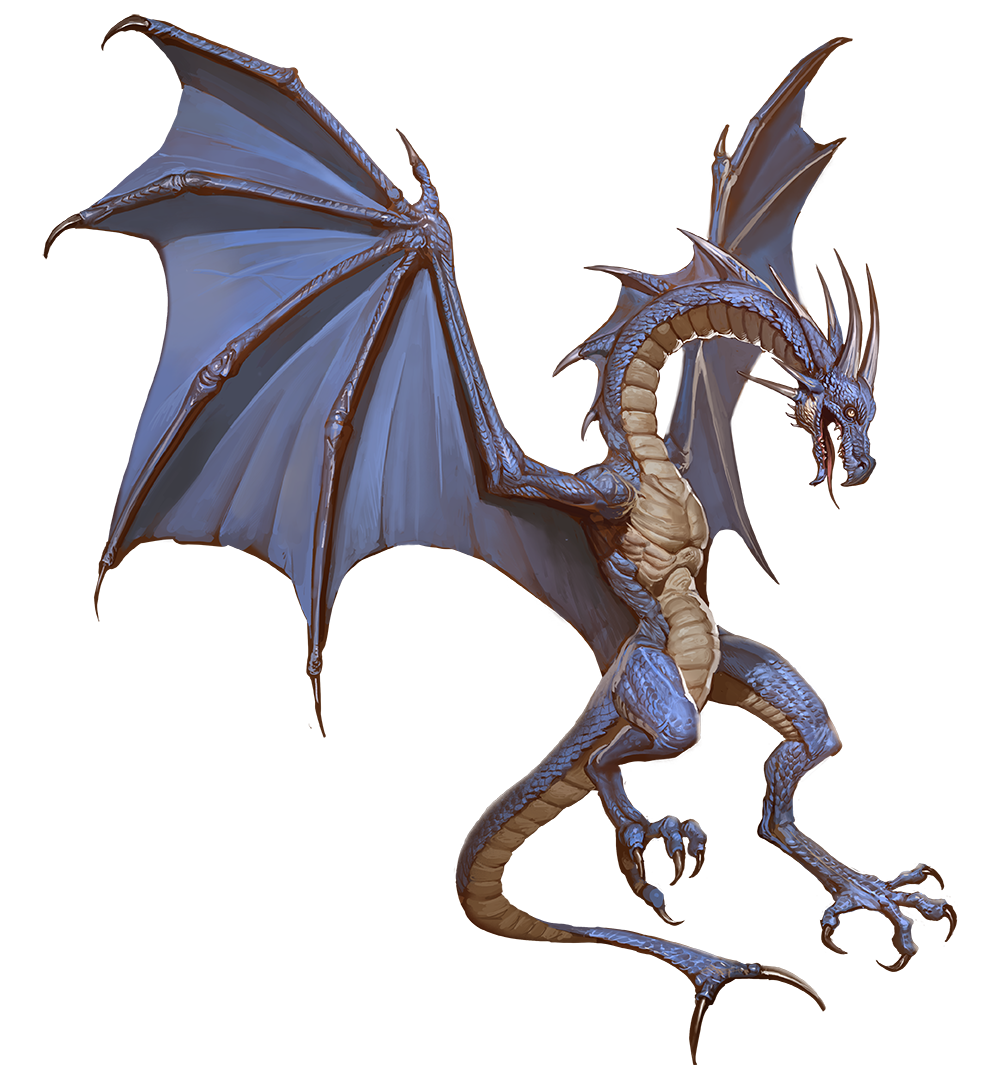D&D Monster Monday: Wyvern

An audible crunch erupts from the twigs beneath your boots. The once sleeping wyvern jolts awake, emitting an eardrum-shattering roar as its eyes lock onto you. You’ve butchered the ambush. The fight is on.
As you may have noticed, I took a brief hiatus from Dungeon Solvers. This was to free up some time to hit my deadlines for a paid commission that I should be able to show off soon.
Also because Monster Hunter: Rise came out. I love writing, but I love gliding through the air and smacking things with an insect glaive too.
So, what could be a more fitting official return to writing weekly articles than to revive the D&D Monster Monday series with some monster hunter flair? That’s right. Today we’re talking all about wyverns!
Let’s feast on some dango and depart on a quest into the Monster Manual to hunt a wyvern!

Wyvern Lore
Wyverns are the little cousins of dragons. Their general physiology is similar to the dragon albeit with a few noticeable differences.
The first is that they have a poison-tipped stinger for a tail. Wyverns use this to pierce their prey whilst flying above them, injecting them with a potent poison and making it easier for them to swoop down and finish them off.
Dragons also use their tails in combat, but it’s more of a bludgeoning weapon used to fend off flankers.
The other difference is that wyverns in D&D have two legs whereas proper dragons have four. Due to this, wyverns partake in ariel combat, swooping down to attack their target while staying in the air.
Also, I’m specifying the “in D&D” part here because I see so many “hot takes” about what’s a wyvern or a dragon in various fantasy worlds/books/movies. It’s like the whole “GANDALF IS ACTUALLY A FIGHTER” take because he’s not slinging fireballs 24/7.
Tangent aside. Wyverns also differentiate from their dragon cousins in their behavior. They tend to take on a beast-like predator pattern of behavior of seeking out prey and killing it rather than dousing villages in flames to collect their riches.
They’re also reckless. Once they seek out their prey they’ll only retreat if they’ve sustained serious injuries.
Beware if you’re a starry-eyed party of adventurers looking for a profitable beast to hunt. This isn’t a creature that’s going to back down so you’d best be ready to kill it.
Wyvern Stats and Abilities
You can find the wyvern’s statblock on page 303 of the Monster Manual.
Stats
Size: Large dragon
AC: 13 (natural armor)
HP: 110 (13d10 + 39)
Speed: 20 ft., fly 80 ft.
STR: 19 (+4)
DEX: 10 (+0)
CON: 16 (+3)
INT: 5 (-3)
WIS: 12 (+1)
CHA: 6 (-2)
The wyvern is by no means a defensively gifted creature. While 110 HP is decent for a CR 6 creature, it’s not great when paired with 13 AC. A well-coordinated adventuring party will tear through a wyvern in no time.
Its lightning-fast flying speed sort of makes up for this. 80 ft. of movement is over 2x the speed of an average medium-sized adventurer. It’s plenty of movement to help them retreat from a hairy situation so they can rest up and re-engage the party at a later time.
Although, between their 20 ft. of movement and abysmal defenses, if the party can ground a wyvern it’s assuredly a dead dragon.
Their ability score array is o.k. Their Consitution and Strength are both solid, which is an overall boon for a melee striker-type creature. They can dish out some impressive damage.
Although the rest of their ability scores are quite mediocre. Particularly their Intelligence and Charisma.
Overall their common saving throw abilities are in a decent spot with the three core ability scores spanning from “great” to “mediocre”.
Resistances, Immunities, Saves, and Skills
Skills: Perception +4
Senses: darkvision 60 ft., passive Perception 14
Languages: None
CR: 6 (2,300 XP)
I’m just as surprised as you are that the wyvern is missing an entire traits section. I figured Flyby was a shoo-in for a high-speed aerial glass cannon. Oh well.
Between their similarities to beast-type predators and dragons, it should come as no surprise that wyverns are perceptive creatures. Although due to their low Wisdom, they’re not as perceptive as their dragon cousins.
All in all CR 6 is appropriate for the wyvern. Although it might not sound it thus far in the analysis, their high potential damage is what pushes them up to this CR.
Actions
Multiattack. The wyvern makes two attacks: one with its bite and one with its stinger. While flying, it can use its claws in place of one other attack.
Bite. Melee Weapon Attack: +7 to hit, reach 10 ft., one creature. Hit: 11 (2d6 + 4) piercing damage.
Claws. Melee Weapon Attack: +7 to hit, reach 5 ft., one target. Hit: 13 (2d8 + 4) slashing damage.
Stinger. Melee Weapon Attack: +7 to hit, reach 10 ft., one creature. Hit: 11 (2d6 + 4) piercing damage. The target must make a DC 15 Constitution saving throw, taking 24 (7d6) poison damage on a failed save, or half as much damage on a successful one.
The wyvern is both a deadly and highly versatile attacker. Their two-attack Multiattack allows them to swap attacks in-and-out of the standard Multiattack to help you plan what you need for any particular combat round.
For example, the standard Multiattack deals an average of 46 damage between Bite and Stinger. However, if the wyvern is flying you can opt to swap either of these attacks out for a Claws attack, making Multiattack deal an average of either 24 or 48 damage.
Realistically, you’d never swap out Stinger due to its high potential poison damage, but I guess it’s at least an option.
We also need to consider the effectiveness of Reach which only the wyvern’s Bite and Stinger attacks have. For a low-defense creature without Flyby that needs to be flying to be effective, the extra reach in the standard Multiattack is an enormous boon.
The only scenario I could see myself using Claws instead of Bite would be if my wyvern was locked in the melee range of an enemy due to something like Sentinel or other movement prevention. In this case, you might as well take the extra damage since you’re screwed anyway.
Wyvern Strengths
Ample Positioning Tools
Due to the lack of flyby, being totally reckless with your wyvern is a recipe for disaster. You’ll want to be selective with when and how you choose to position the wyvern. Thankfully, you do at least have plenty of tools to help you in this endeavor.
Their 80 ft. of flying speed gives you ample opportunities for positioning and repositioning during a turn. You can dive in, make your Multiattack and then swoop out and hide behind a tree or soar up into the air to avoid melee attacks from the party.
Their Bite and Stinger having a Reach of 10 ft. also gives them a small movement buffer to give them more positioning options as well as avoid Opportunity Attacks from creatures whose melee range is 5 ft.

High Potential Damage from Stinger
Stinger the golden goose of the wyvern’s statblock. its 11 piercing damage is decent in its own right, but the 24 (7d6) poison damage behind a failed DC 15 Constitution saving throw is a terrifying prospect to deal with in combat.
The good news is that while the overwhelming majority of players would never dump Constitution, DC 15 is still a respectable saving throw to make. For instance, a PC with a +3 CON modifier only has a 40% chance of making the saving throw.
Plus, even if the target makes the save, they’ll still take half damage.
Stinger has a ton of damage potential, but it’s also really consistent and reliable. It’s the cornerstone of the wyvern’s statblock for a reason.
Wyvern Weaknesses
Abysmal Defenses
When I call the wyvern a glass cannon, I mean it’s a glass cannon.
This is a CR 6 creature with 13 AC and, while it does have a respectable amount of HP, it has no damage resistances or immunities to back it up.
Its common saving throw abilities are decent, but again, they have no condition immunities to aid them.
Oh… and no FLYBY!
Highly Susceptible to Reach Weapons and Sentinel
Movement and positioning are key to the wyvern’s success and survival in combat. Their low AC and lack of flying means that if Bite and Stinger’s 10 ft. of Reach is matched by their target, they’re taking an Opportunity Attack each time they swoop in to attack the target.
Not to mention the fact that if wyvern is unlucky enough to make this mistake against a PC with the Sentinel feat they’re done for. Dropping the wyvern to 0 speed and allowing the rest of the party to nuke it for an entire round by knocking it out of the air is essentially game over for the wyvern.
Their only option, should they survive the devastation, is to Disengage and retreat.
How to Play a Wyvern
Use Your Reach
The number one rule to playing a wyvern is to never land. They’re sitting ducks when grounded due to their abysmal 20 ft. of ground speed.
This means that you’ll need to be creative in positioning your wyvern just above their target to utilize their Bite and Stinger’s 10 ft. of Reach. This ensures that you can hit most enemies, but they won’t make an Opportunity Attack against you unless they also have a Reach of 10 ft.
This tends to mean that the creature has a reach weapon like a whip or a glaive.
Although with a -3 Intelligence modifier, your wyvern probably won’t be keen to understand the limitations and capabilities of humanoid weapons. Though their Wisdom allows them to realize that if a target can make an OA against them, it’s best to avoid them in future rounds.
Regardless, use this hover above and strike from afar approach to help your wyvern avoid pesky melee attackers, giving them a much-needed boost to their survivability.

Retreat When Possible
Wyverns are bull-headed creatures. Once they lock onto a target they’re going to pursue it until either they or it dies.
Well, most of the time anyway. Wyverns are intelligent to know when their bodies are broken and they’re risking certain death if they continue to hunt their target. While this isn’t a frequent occurrence, it’s an option that you should consider when piloting a wyvern.
Ironically, their 80 ft. of flying speed is the perfect tool for them to Dash or Disengage away from the party and retreat. Allowing them to rest up, heal their wounds, and then hunt down the party when they least expect it.
This makes a wyvern hunt a multi-encounter adventure in which the party needs to track and finish off the wyvern before they can fly away to heal up…. much like Monster Hunter.
5 Wyvern Plot Hooks
- Get the Eggs! – Wyvern eggs are a delicacy due to how difficult it is to procure one. High-class chefs and upperclass gourmets will pay a high price to adventurers that can bring them one in-tact.
- A Tall Tail – After a perilous adventure to aid the town’s blacksmith, they promised you a custom-made item as a reward. Your fighter has comissioned a one-of-a-kind spear. There’s just one problem, the blacksmith needs a wyvern’s stinger for the spear’s poisoned tip.
- Rampaging Wyverns – Something has set-off the local wyvern population turning them from hunters to serial killers that murder any beast they see. Either the wyverns or whatever is causing this must be stopped before the forest’s ecosystem is irreversibly damaged.
- A Compromised Trade Route – The winding road through the mountain pass has been used to trade between two towns for centuries. Recently, a flock of wyverns have made a nest nearby and have begun attacking the caravans that travel through this passage.
- How to Train Your Wyvern – A local teen is looking for adventuers to help them capture a wyvern so they can train it to be ridden. They believe they can save their whole village by equipping them with rideable wyverns. After losing a couple of limbs and working the kinks out, they believe this time their plan will work.
Conclusions
Wyverns, while dragonlike in appearance and physiology, serve a different niche in D&D. Instead of hoarding gold, terrorizing towns, or assembling a cult of followers, wyverns are simple predators that live to hunt and feast upon creatures in the forests and mountains of various D&D locations.
Don’t underestimate them. Wyverns are still terrifying creatures to encounter due to their poisonous stinger, high flying speed, and 10 ft. Reach. These creatures can outmaneuver and out position just about any adventuring party.
They’re the perfect creature to ambush the party as they travel to their next quest or destination because if the party doesn’t kill them immediately, they’ll be haunted the entire way by this enraged dragon.

I do enjoy Monster Mondays! Hadn’t really seen the potential of the humble wyvern before, but a couple of these harrying PCs over a mountain pass could really add some drama.